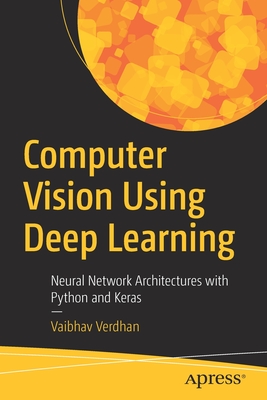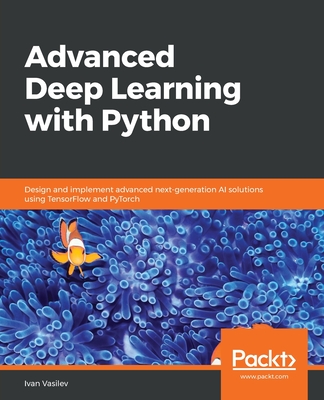Learning Deep Learning: Theory and Practice of Neural Networks, Computer Vision, Nlp, and Transformers Using Tensorflow (Paperback)
暫譯: 學習深度學習:使用 TensorFlow 的神經網絡、計算機視覺、自然語言處理與變壓器的理論與實踐(平裝本)
Magnus Ekman
- 出版商: Addison Wesley
- 出版日期: 2021-08-17
- 定價: $2,680
- 售價: 9.5 折 $2,546
- 語言: 英文
- 頁數: 752
- 裝訂: Paperback
- ISBN: 0137470355
- ISBN-13: 9780137470358
-
相關分類:
DeepLearning、TensorFlow、Text-mining、Computer Vision
-
相關翻譯:
跟 NVIDIA 學深度學習!從基本神經網路到 ......、GPT、BERT...,紮穩機器視覺與大型語言模型 (LLM) 的建模基礎 (繁中版)
基於 TensorFlow 的深度學習:神經網絡、電腦視覺和 NLP 的理論與實踐 (簡中版)
立即出貨 (庫存 < 3)
買這商品的人也買了...
-
 $403深入理解機器學習:從原理到算法 (Understanding Machine Learning : From Theory to Algorithms)
$403深入理解機器學習:從原理到算法 (Understanding Machine Learning : From Theory to Algorithms) -
 Automatic Control Systems, 10/e (IE-Paperback)
Automatic Control Systems, 10/e (IE-Paperback)$1,380$1,352 -
 特徵工程不再難:資料科學新手也能輕鬆搞定! (Feature Engineering Made Easy: Identify unique features from your dataset in order to build powerful machine learning systems)
特徵工程不再難:資料科學新手也能輕鬆搞定! (Feature Engineering Made Easy: Identify unique features from your dataset in order to build powerful machine learning systems)$520$406 -
 深度學習 -- 硬體設計
深度學習 -- 硬體設計$750$675 -
 和艦長一起 30 天玩轉 GitLab(iT邦幫忙鐵人賽系列書)
和艦長一起 30 天玩轉 GitLab(iT邦幫忙鐵人賽系列書)$500$390 -
 VR 與 AR 開發高級教程 : 基於 Unity, 2/e
VR 與 AR 開發高級教程 : 基於 Unity, 2/e$599$569 -
 智慧新世界--圖靈所沒有預料到的人工智慧
智慧新世界--圖靈所沒有預料到的人工智慧$400$316 -
 Computer Vision Using Deep Learning: Neural Network Architectures with Python and Keras
Computer Vision Using Deep Learning: Neural Network Architectures with Python and Keras$1,630$1,549 -
 $911AI 芯片:前沿技術與創新未來
$911AI 芯片:前沿技術與創新未來 -
 資料科學的建模基礎 : 別急著 coding!你知道模型的陷阱嗎?
資料科學的建模基礎 : 別急著 coding!你知道模型的陷阱嗎?$599$473 -
 $2,622Practical Machine Learning for Computer Vision: End-To-End Machine Learning for Images (Paperback)
$2,622Practical Machine Learning for Computer Vision: End-To-End Machine Learning for Images (Paperback) -
 AI 影像深度學習啟蒙 : 用 Python 進行人臉口罩識別
AI 影像深度學習啟蒙 : 用 Python 進行人臉口罩識別$880$695 -
 你所不知道的必學前端 Debug 技巧:即學即用!讓你 Debug 不求人 (iT邦幫忙鐵人賽系列書)
你所不知道的必學前端 Debug 技巧:即學即用!讓你 Debug 不求人 (iT邦幫忙鐵人賽系列書)$620$484 -
 資料科學的統計實務 : 探索資料本質、扎實解讀數據,才是機器學習成功建模的第一步
資料科學的統計實務 : 探索資料本質、扎實解讀數據,才是機器學習成功建模的第一步$599$473 -
 Deep Learning with Python, 2/e (Paperback)
Deep Learning with Python, 2/e (Paperback)$2,300$2,185 -
 資安這條路:領航新手的 Web Security 指南,以自建漏洞環境學習網站安全(iT邦幫忙鐵人賽系列書)
資安這條路:領航新手的 Web Security 指南,以自建漏洞環境學習網站安全(iT邦幫忙鐵人賽系列書)$680$530 -
 Knock Knock! Deep Learning:新手入門深度學習的敲門磚(iT邦幫忙鐵人賽系列書)
Knock Knock! Deep Learning:新手入門深度學習的敲門磚(iT邦幫忙鐵人賽系列書)$560$437 -
 機器學習的統計基礎 : 深度學習背後的核心技術
機器學習的統計基礎 : 深度學習背後的核心技術$680$537 -
 Java: The Complete Reference, 12/e (Paperback)
Java: The Complete Reference, 12/e (Paperback)$2,460$2,337 -
 High-Dimensional Data Analysis with Low-Dimensional Models: Principles, Computation, and Applications (Hardcover)
High-Dimensional Data Analysis with Low-Dimensional Models: Principles, Computation, and Applications (Hardcover)$1,760$1,725 -
 開發者傳授 PyTorch 秘笈
開發者傳授 PyTorch 秘笈$1,200$948 -
 I'm From Taiwan / Programmer 阿喵宅造型貼紙7X7公分 (萬聖節限定款)
I'm From Taiwan / Programmer 阿喵宅造型貼紙7X7公分 (萬聖節限定款)$69$60 -
 跟 NVIDIA 學深度學習!從基本神經網路到 ......、GPT、BERT...,紮穩機器視覺與大型語言模型 (LLM) 的建模基礎
跟 NVIDIA 學深度學習!從基本神經網路到 ......、GPT、BERT...,紮穩機器視覺與大型語言模型 (LLM) 的建模基礎$880$695 -
 人工智能芯片設計
人工智能芯片設計$419$398 -
 從演算法到電路:數碼芯片演算法的電路實現
從演算法到電路:數碼芯片演算法的電路實現$714$678
商品描述
NVIDIA's Full-Color Guide to Deep Learning: All You Need to Get Started and Get Results
To enable everyone to be part of this historic revolution requires the democratization of AI knowledge and resources. This book is timely and relevant towards accomplishing these lofty goals.
-- From the foreword by Dr. Anima Anandkumar, Bren Professor, Caltech, and Director of ML Research, NVIDIA
Ekman uses a learning technique that in our experience has proven pivotal to success--asking the reader to think about using DL techniques in practice. His straightforward approach is refreshing, and he permits the reader to dream, just a bit, about where DL may yet take us.
-- From the foreword by Dr. Craig Clawson, Director, NVIDIA Deep Learning Institute
Deep learning (DL) is a key component of today's exciting advances in machine learning and artificial intelligence. Learning Deep Learning is a complete guide to DL. Illuminating both the core concepts and the hands-on programming techniques needed to succeed, this book is ideal for developers, data scientists, analysts, and others--including those with no prior machine learning or statistics experience.
After introducing the essential building blocks of deep neural networks, such as artificial neurons and fully connected, convolutional, and recurrent layers, Magnus Ekman shows how to use them to build advanced architectures, including the Transformer. He describes how these concepts are used to build modern networks for computer vision and natural language processing (NLP), including Mask R-CNN, GPT, and BERT. And he explains how a natural language translator and a system generating natural language descriptions of images.
Throughout, Ekman provides concise, well-annotated code examples using TensorFlow with Keras. Corresponding PyTorch examples are provided online, and the book thereby covers the two dominating Python libraries for DL used in industry and academia. He concludes with an introduction to neural architecture search (NAS), exploring important ethical issues and providing resources for further learning.
- Explore and master core concepts: perceptrons, gradient-based learning, sigmoid neurons, and back propagation
- See how DL frameworks make it easier to develop more complicated and useful neural networks
- Discover how convolutional neural networks (CNNs) revolutionize image classification and analysis
- Apply recurrent neural networks (RNNs) and long short-term memory (LSTM) to text and other variable-length sequences
- Master NLP with sequence-to-sequence networks and the Transformer architecture
- Build applications for natural language translation and image captioning
NVIDIA's invention of the GPU sparked the PC gaming market. The company's pioneering work in accelerated computing--a supercharged form of computing at the intersection of computer graphics, high-performance computing, and AI--is reshaping trillion-dollar industries, such as transportation, healthcare, and manufacturing, and fueling the growth of many others.
Register your book for convenient access to downloads, updates, and/or corrections as they become available. See inside book for details.
商品描述(中文翻譯)
NVIDIA 的全彩深度學習指南:開始和獲得成果所需的一切
為了讓每個人都能參與這場歷史性的革命,需要實現人工智慧知識和資源的民主化。本書在實現這些崇高目標方面恰逢其時且相關性強。
-- 摘自加州理工學院布倫教授、NVIDIA 機器學習研究主任 Dr. Anima Anandkumar 的前言
Ekman 使用了一種在我們的經驗中被證明對成功至關重要的學習技術——要求讀者思考如何在實踐中使用深度學習技術。他的直接方法令人耳目一新,並讓讀者稍微夢想一下深度學習可能帶我們去的地方。
-- 摘自 NVIDIA 深度學習研究所主任 Dr. Craig Clawson 的前言
深度學習 (DL) 是當今機器學習和人工智慧令人興奮的進展中的關鍵組成部分。學習深度學習 是一本完整的深度學習指南。這本書闡明了成功所需的核心概念和實用的程式設計技術,非常適合開發人員、數據科學家、分析師及其他人,包括那些沒有機器學習或統計經驗的人。
在介紹深度神經網絡的基本構建塊後,例如人工神經元、全連接層、卷積層和遞迴層,Magnus Ekman 展示了如何使用它們來構建先進的架構,包括 Transformer。他描述了這些概念如何用於構建現代的計算機視覺和自然語言處理 (NLP) 網絡,包括 Mask R-CNN、GPT 和 BERT。他還解釋了如何構建自然語言翻譯器和生成圖像自然語言描述的系統。
在整本書中,Ekman 提供了使用 TensorFlow 和 Keras 的簡潔且註解良好的程式碼範例。對應的 PyTorch 範例在線提供,因此本書涵蓋了業界和學術界使用的兩個主流 Python 深度學習庫。他以對神經架構搜索 (NAS) 的介紹作結,探討重要的倫理問題並提供進一步學習的資源。
- 探索並掌握核心概念:感知器、基於梯度的學習、sigmoid 神經元和反向傳播
- 了解深度學習框架如何使開發更複雜和有用的神經網絡變得更容易
- 發現卷積神經網絡 (CNN) 如何徹底改變圖像分類和分析
- 將遞迴神經網絡 (RNN) 和長短期記憶 (LSTM) 應用於文本和其他變長序列
- 使用序列到序列網絡和 Transformer 架構掌握自然語言處理
- 構建自然語言翻譯和圖像標題生成的應用程序
NVIDIA 的 GPU 發明引發了 PC 遊戲市場。該公司在加速計算方面的開創性工作——一種在計算機圖形、高性能計算和人工智慧交匯處的超強計算形式——正在重塑萬億美元的行業,如交通、醫療保健和製造業,並推動許多其他行業的增長。
註冊您的書籍以便方便訪問下載、更新和/或更正,隨著它們的可用性而提供。詳情請參見書內。
作者簡介
Magnus Ekman, Ph.D., is a director of architecture at NVIDIA Corporation. His doctorate is in computer engineering, and he is the inventor of multiple patents. He was first exposed to artificial neural networks in the late nineties in his native country, Sweden. After some dabbling in evolutionary computation, he ended up focusing on computer architecture and relocated to Silicon Valley, where he lives with his wife Jennifer, children Sebastian and Sofia, and dog Babette. He previously worked with processor design and R&D at Sun Microsystems and Samsung Research America, and has been involved in starting two companies, one of which (Skout) was later acquired by The Meet Group, Inc. In his current role at NVIDIA, he leads an engineering team working on CPU performance and power efficiency for system on chips targeting the autonomous vehicle market.
As the Deep Learning (DL) field exploded the past few years, fueled by NVIDIA's GPU technology and CUDA, Dr. Ekman found himself in the middle of a company expanding beyond computer graphics into becoming a deep learning (DL) powerhouse. As a part of that journey, he challenged himself to stay up-to-date with the most recent developments in the field. He considers himself to be an educator, and in the process of writing Learning Deep Learning ( LDL), he partnered with the NVIDIA Deep Learning Institute (DLI), which offers hands-on training in AI, accelerated computing, and accelerated data science. He is thrilled about DLI's plans to add LDL to its existing portfolio of self-paced online courses, live instructor-led workshops, educator programs, and teaching kits.
作者簡介(中文翻譯)
**Magnus Ekman, Ph.D.** 是 NVIDIA Corporation 的架構總監。他的博士學位為計算機工程,並且是多項專利的發明人。他在九十年代末期首次接觸到人工神經網絡,當時他身處於他的故鄉瑞典。在對進化計算進行了一些嘗試後,他最終專注於計算機架構,並搬遷到矽谷,與妻子 Jennifer、孩子 Sebastian 和 Sofia 以及狗 Babette 一起生活。他曾在 Sun Microsystems 和 Samsung Research America 從事處理器設計和研發工作,並參與創辦了兩家公司,其中一家公司(Skout)後來被 The Meet Group, Inc. 收購。在 NVIDIA 的目前職位中,他領導一個工程團隊,專注於針對自動駕駛車輛市場的系統單晶片的 CPU 性能和功率效率。
隨著深度學習(Deep Learning, DL)領域在過去幾年迅速發展,受到 NVIDIA 的 GPU 技術和 CUDA 的推動,Ekman 博士發現自己身處於一個超越計算機圖形的公司,成為深度學習(DL)強者。在這段旅程中,他挑戰自己保持對該領域最新發展的了解。他認為自己是一位教育者,在撰寫《Learning Deep Learning》(LDL)的過程中,他與 NVIDIA 深度學習學院(Deep Learning Institute, DLI)合作,該學院提供人工智慧、加速計算和加速數據科學的實作訓練。他對 DLI 計劃將《LDL》納入其現有的自學在線課程、現場講師主導的工作坊、教育者計劃和教學套件的計劃感到非常興奮。





























